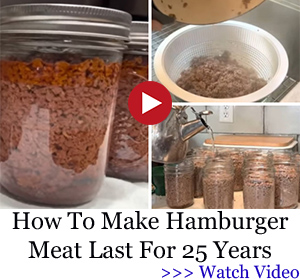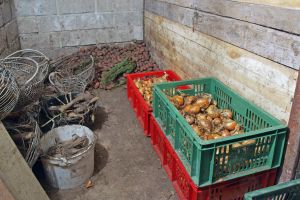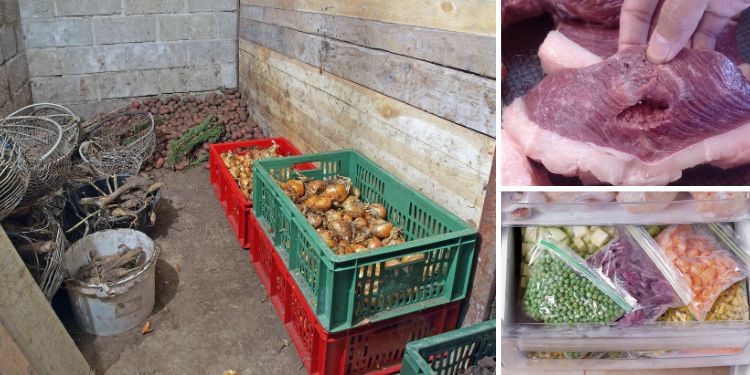As preppers are well aware, preparing your home and family for long-term crises and emergencies involves accumulating a substantial food supply.
When it comes to protecting a large food supply, many people focus on the threat of looters and marauders. However, the true enemies of your food supply are likely to be far less dramatic.
The Biggest Enemies of Food Storage
Whether you’re putting up the food you bought at the store or produce from your own organic garden, a full pantry represents a significant investment of time and money. Protecting it from these six food storage enemies takes planning, patience, and persistence:
- Time
- Light
- Oxygen
- Pests
- Temperature
- Moisture
Looters can also threaten food supplies, but in this article, we’re focusing on the six enemies listed above because they are the most common, and we encounter them every day.
Time
 Time has a way of wearing everything down.
Time has a way of wearing everything down.
Everyone knows that various storage methods lead to a wide range of outcomes. For example, dried beans can be stored much longer than canned beans, which can be stored much longer than cooked beans in the refrigerator.
Related: How to Dry Can Beans and Rice for 20+ Years Shelf Life
Not only do you need to understand the best preservation method for the food you’re storing, but you also need to know the life expectancy of the food in your pantry. Sometimes, old food can still be safe to eat, but time has rendered it rancid or imparted an odd flavor or odor, so it won’t be palatable.
Solution
Label and date everything in your pantry, including storage and expiration dates. It’s handy to have that information easily accessible when you’re inventorying your food pantry and rotating your stock. That way, you can use or discard expired items and replenish your pantry to help keep this food enemy at bay.
Light
 Just like UV rays cause wood to fade and plant material to disintegrate, they also cause your food to go bad.
Just like UV rays cause wood to fade and plant material to disintegrate, they also cause your food to go bad.
Over time, exposure to light causes food to break down, degrading its nutritional value, color, and flavor. Vitamins A, C, E and thiamine are particularly vulnerable to light and deteriorate rapidly when exposed to it.
Light can affect foods that have a high fat content, like nuts and oils. When these foods are exposed to light, the fats oxidize and turn rancid. Not only do rancid foods taste bad, but the oxidation can also produce chemical compounds that are harmful to your health.
Solution
Store foods in areas with minimal light exposure, like your root cellar, basement, or pantry without windows. If your pantry does have a window, use a blackout curtain. Consider storing foods like nuts, oils, and grains in dark, opaque containers like amber jars or metal tins.
Air
 The air in your home, pantry, or root cellar might seem empty, but it’s full of bacteria, mold, and yeast spores. Exposure to air is a problem and explains why you can safely eat a rare steak, but you shouldn’t eat a rare hamburger. While the surface of the steak has never been exposed to air, the hamburger has been ground, exposing all those small surface areas to bacteria that are in the air.
The air in your home, pantry, or root cellar might seem empty, but it’s full of bacteria, mold, and yeast spores. Exposure to air is a problem and explains why you can safely eat a rare steak, but you shouldn’t eat a rare hamburger. While the surface of the steak has never been exposed to air, the hamburger has been ground, exposing all those small surface areas to bacteria that are in the air.
In addition, air is made up of about 20% oxygen, which is one of the biggest enemies of food. Oxygen feeds the microorganisms that attack your food, causing food to spoil faster.
As we saw with light, oxidation changes the chemical composition of food and causes it to break down. Oxidation typically involves both light energy and oxygen, but some types of oxidation can occur without oxygen. However, removing air by creating a vacuum removes most of the elements that cause oxidation.
Solution
 Creating a barrier between your food and the surrounding air is critical to minimizing exposure to protect your food.
Creating a barrier between your food and the surrounding air is critical to minimizing exposure to protect your food.
Airtight containers are a good choice for many types of food, like grains, rice, and beans.
Vacuum sealing is another option that works well with food preservation methods like dehydrating and freezing and will help keep all types of food preserved longer.
Pests
Almost no other problem associated with food storage is as discouraging as pests. Whether it’s issues with rodents in your root cellar or bugs in your flour, pests can ruin food supplies in a matter of days.
Rats and mice can chew through food packages and contaminate your pantry with droppings and urine. Insects like weevils, beetles, and cockroaches can get in your flour, pasta, cereals, and grains and make them inedible.
Pest infestations can quickly spread and destroy your entire food supply. Even worse, rodents are well-known to carry pathogens, including bacteria and viruses, which is what happened during the Bubonic Plague. Insects can carry diseases, too, including salmonella and listeria.
Addressing pest infestations requires prompt action and effective pest management strategies. Ignoring the problem will lead to even greater losses.
Solution
Integrated pest management solutions are the key to solving issues with rodents and insects in your food supplies.

Prevention should be the priority, and you can start by keeping your food supplies in a sealed area without cracks and using pest-proof containers. Clean spills immediately and regularly inspect the area for signs of pests. Other approaches to include in your overall pest management plan include traps, baits, and natural repellents.
Temperature
Various types of food can be stored for different lengths of time at different temperatures. High and low temperatures can ruin food, but it’s also important to avoid temperature fluctuations, especially with grains, beans, and flour. Temperature fluctuations can lead to condensation in a food container, and moisture will promote the growth of mold, yeast, and bacteria.
If you have frozen foods and experience a power outage, your food may start to thaw. As soon as the conditions are right, the naturally present bacteria in organic matter will start to flourish, and your food will begin to spoil. Although you may choose to refreeze it, you should consider changing the expiration date. Learn here what to do with all your frozen food once the power goes out.
With home canned goods, temperatures over 100° F (38° C) can cause food spoilage, especially if they are left at high temperatures for long periods. The risk of food spoilage goes up with increased temperatures.
Solution
 Not everyone lives in a perfectly climate-controlled house, and you may have to deal with some temperature fluctuations. Ideally, your food storage location should be cool with a stable temperature. Many root cellars are deep and well-insulated enough to maintain year-round temperatures of 40° to 45° F (4° to 7° C), making them one of the best places to store food.
Not everyone lives in a perfectly climate-controlled house, and you may have to deal with some temperature fluctuations. Ideally, your food storage location should be cool with a stable temperature. Many root cellars are deep and well-insulated enough to maintain year-round temperatures of 40° to 45° F (4° to 7° C), making them one of the best places to store food.
Moisture
Whether your food is stored in an underground bunker, root cellar, freezer, refrigerator, or pantry in your kitchen, moisture and humidity levels can impact its longevity.
Some foods, like root vegetables, actually do better with some humidity, which is why they store well on the floor of your root cellar. However, other foods do not tolerate moisture at all, and even a small amount of condensation inside a container of dried goods can ruin it.
Related: Root Cellar Mistakes You Need to Avoid at All Costs
Too much condensation can lead to faster spoilage in frozen and refrigerated foods, like when you see the condensation in plastic containers in your refrigerator. Sometimes, the condensation in frozen food packages causes freezer burn, which impacts the flavor and texture of the food.
Solution
 Start by ensuring that your food storage areas have the right humidity level.
Start by ensuring that your food storage areas have the right humidity level.
For example, in a damp root cellar, you may need to consider using a dehumidifier and increasing air circulation by adding vents. While foods like dried goods require packaging in an airtight container, other foods need a little air.
Store fruits and vegetables in your root cellar in burlap bags, pantyhose, wooden crates, or mesh bags to allow air circulation and prevent moisture buildup.
Avoid overpacking containers when packaging food for long-term storage. When freezing vegetables, drain them well after blanching and blot them dry with a towel to remove as much moisture as possible.
Mastering Food Storage Techniques for Long-term Prepping
When it comes to long-term preparedness, there’s a lot to know. Mastering food storage techniques starts with a basic understanding of these six key enemies, but it doesn’t end there. Continually learning and trying new things to see what works for you, your family, climate, region, and food storage areas will take you on a lifelong journey.
Each type of food and every preservation method presents unique challenges, but if you stay open-minded to learning new techniques as they come along, you can be in a better position to protect your food supply.
Every prepper has a story about food preservation or something that others can learn from! Share your biggest challenges and victories related to this topic in the comments below, and hopefully, we can all learn from each other how to keep food safe, fresh, and ready for any situation.
You may also like:
 8 Worst American States to Be in When SHTF
8 Worst American States to Be in When SHTF
Why You Should Never Build a Tall Fence Around Your House (Video)















It would be vreat to see some information about using dessicants in dry or vacuumed storage – how much, what size packet per weight unit e.g. one pound bag of dry lentils. Thanks
A container measuring 15” x 15” x 12” has an internal volume of 2,700 cubic inches, or about 1.6 cubic feet. Such a container will need approximately 1.9-units of desiccant (1.6 multiplied by 1.2) to keep dry.
There are dessicants and there are oxygen (O2) absorbers. They are not the same thing, and most would advise not using both together.
Dessicants keep things dryer, while oxygen absorbers reduce the amount of available oxygen.
For dried foods like lentils or beans, I prefer to use O2 absorbers. You need to know the size of container or bag you’re using to know how much you need to add.
Both come in different sizes. When using either one, you want to work as quickly as you can so they can work well in your containers.
I use 200 cc O2 absorbers when storing dried goods in half gallon containers. You can do the math, figure out the head space and calculate the residual air to determine how much exactly. I tend to stick to 100cc/quart or liter to keep things easy.
I tend to break things down to smaller packages. Many sites will give you info for a 5-gallon bucket of x. If you are cooking for an army, then you may find the 5-gallon info very useful. I MUCH prefer taking the 5-gallon bucket of x and break it down to 10 half-gallon mylar bags. In my world, I can use one of the bags now and keep the others on hand for later. I think the integrity of the food is better kept because I’m not continually opening and closing the 5-gallon bucket of X to retrieve the foods I need. Vermin can chew through plastic, so I prefer using clean galvanized trash cans for the impermeable container. They come in different sizes. You can fit a lot of mylar bags in a 32-gallon trash can! The smaller sized ones like 6 gallons are great for boating or camping trips.
I can open that half-gallon bag, use what I need, and store the rest in a glass jar. If I keep the food in the mylar bag and place that working bag in the glass jar, I can keep out light and have an impermeable container against bugs and rodents.
The advantage to smaller containers is also helpful if you are in a situation where you need to leave in a hurry. A small child won’t be able to carry a 5-gallon bucket full of beans, but putting a half-gallon mylar bag of beans in her backpack is quick, easy, and can make a difference.
I use dessicants more often in my working bags or jars. My “working” container tends to be a size I think I’ll need for a specified time period, typically several months at most. I live in a humid place, so if I have a working jar of dehydrated food that I know I’ll open often before it’s all used up, I put a dessicant packet in there to help preserve the integrity. I also use tight fitting lids and try to close the container as soon as possible.
I don’t understand why it would be a problem to remove moisture AND oxygen from stored dry foods like rice, beans, etcetera.
Looters yes, hungry illegals and terrorist wanting free food too. Rats and mice will attack plastic storage containers. Causing holes for moisture, mold and bacteria to invade the food.
Stored food in modern times does have a limited stable period before we need to replace. Many of us use traditional storage methods, freeze dried devices are too darn expensive for seniors on fixed incomes to use.
Not all places can use root cellars as soils are dry hard clay, rocky hard to dig a decent large root cellar.
So different options must be found for our local use that differ from what authors of posted articles have used for their specific conditions for prepping.
There are flood plain areas an high water table regions where root cellars are impossible to have.
Above ground storage defeats the natural below ground stable climate of the traditional root cellar.
Your right. Like in S FL. The only way to create an underground system here, would be a plastic septic tank and bury it on the shady side of the house.
Hi David. Yeah, a freeze-drying unit can be cost prohibitive, but there are still some options. Used and/or scratch and dent at “Harvest Right”, then there is canning or dehydration. Many of us buy and eat “Slim Jims” and they’ve been packaged for how long? Amazon has “Spam” at a cheap price by the carton. Mine are dated ” best by 2027″. Don’t forget David, not everyone gets these emails and most folks that do are preppers of sorts.
As far as rodents go, spray some diluted peppermint oil, it’s toxic to anything in the rodent family.Use your own imagination on how to best use the peppermint oil making it last longer, mixing it with homemade soap in ice cube trays is one, many others also.
Good afternoon. I discovered freeze drying as a mode of preservation. The equipment may be prohibitive for some, but my experience has this Invesment come back for me 6 plus times in the 3 + yrs. I’ve been freeze-drying meals, veggies, fruit, eggs (cooked and raw), yogurt, ice-cream bars, coffee and more. Mylar bags and DE oxygenators. One of my processes is to pack the bags, put one of those pouches, and vacuum shut the bag. I then just pack them in containers buckets and totes and stack them. I recently opened to taste a 2 yr old Christmas ham. It was amazing. Folks stay vigilant and informed. Thank you, Claude.
Good afternoon. I discovered freeze drying as a mode of preservation. The equipment may be prohibitive for some, but my experience has this Invesment come back for me 6 plus times in the 3 + yrs. I’ve been freeze-drying meals, veggies, fruit, eggs (cooked and raw), yogurt, ice-cream bars, coffee and more. Mylar bags and DE oxygenators. One of my processes is to pack the bags, put one of those pouches, and vacuum shut the bag. I then just pack them in containers buckets and totes and stack them. I recently opened to taste a 2 yr old Christmas ham. It was amazing. Thank you, Claude.
i use dessicants and oxygen absorbers on a regular basis for food preservation. i get them at u-line. its a company that you can get anything at. i use their plastic zip-lock bags for ammo and my wife uses the food grade zip-lock bags for the cinnamon pecans she sells at gunshows when i set up at one. i like to pack several small bags(each with o2 absorbers) into 5 gal. buckets. i then run packing tape around the rim where the lid and bucket meet. i use my shopvac with the crevice tool and put it in the bucket and suck the air out till the lid sucks in then i quickly pull the tool out and finish sealing the lid. i don’t even turn the shopvac off till i’m done,to keep a minimum of air from going back into the bucket. hope this info is useful.